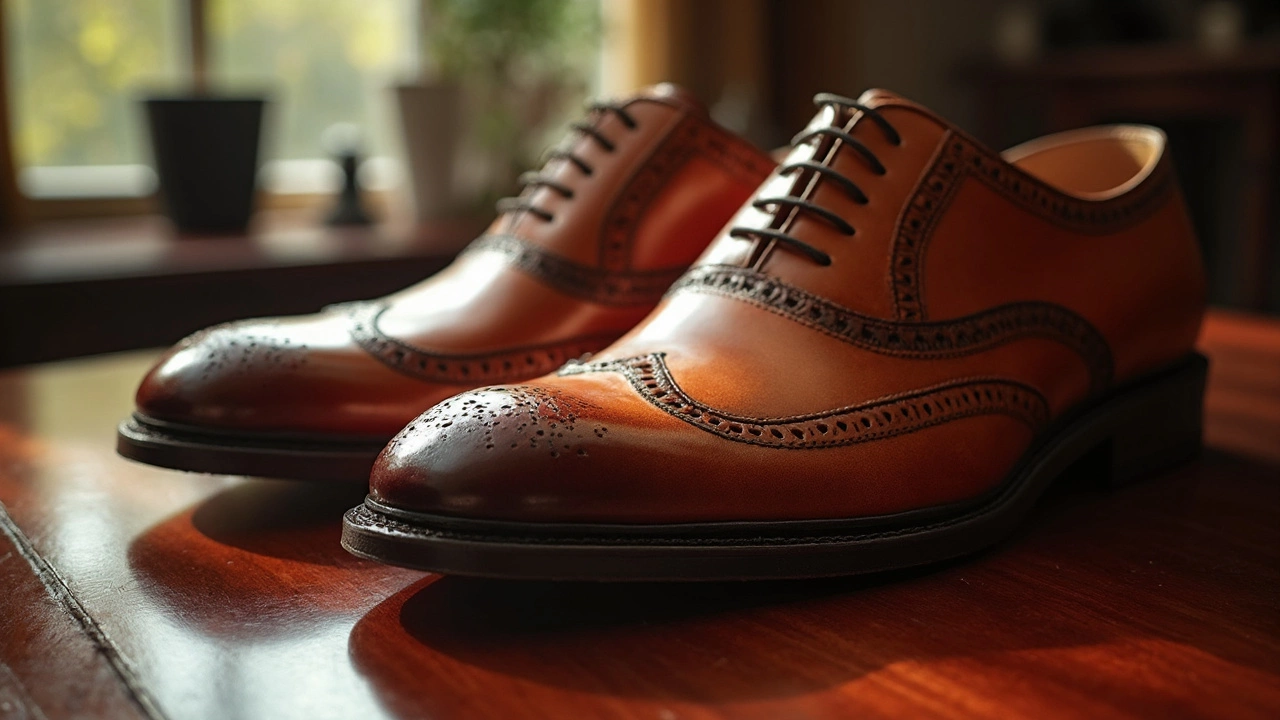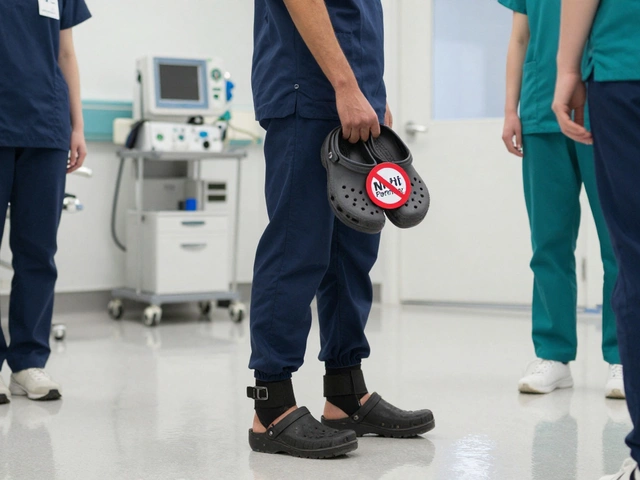How to Tell If Your Leather Shoes Are the Real Deal

- Cleo Fairchild
- 12 April 2025
- 0 Comments
Ever find yourself staring at a pair of shoes, wondering if they’re genuine leather or just a clever-looking fake? You’re not alone. With leather’s enduring popularity, and often hefty price tag, it’s good to know what you’re paying for. Lucky for us, there are a few handy tricks to help figure out if you've got the real thing or a wannabe.
First off, take a good look at the shoes. Real leather usually has a distinctive look—slightly pebbly or uneven surface and sometimes tiny pores, unlike synthetic material, which often looks too perfect and even. It might sound odd, but giving your shoes a good sniff is another great method. Real leather has a unique, rich aroma that’s hard to imitate. If it smells a bit plasticky or chemical, chances are it’s not the real deal.
- Recognizing Leather by Sight
- The All-Important Smell Test
- Texture Tells the Truth
- Water Absorption Test
- Inspecting the Edges
Recognizing Leather by Sight
Spotting genuine leather shoes can be a bit like solving a fun puzzle. One of the first things to pay attention to is the appearance of the surface. Real leather often presents a natural, slightly uneven texture that's not perfectly uniform. You might notice tiny pores or a grainy pattern, attributes that faux leather just can't mimic.
If the material looks too flawless or seems almost plastic-like, it's a big hint that it's synthetic. Another tip is to check the color consistency. Genuine leather usually has some variations and deeper, richer hues, whereas fake leather tends to have a more consistent, sometimes overly vibrant tone.
Also, have a peek at the backside of the leather. Real leather has a rougher, fibrous back, different from the plastic-like backing found on synthetic materials. Being a detective about the details can save you from investing in something that won't stand the test of time.
| Feature | Real Leather | Fake Leather |
|---|---|---|
| Texture | Slightly uneven, with tiny pores | Smooth, overly perfect |
| Color Variation | Variations in color depth | Consistent, uniform color |
| Backside | Rough, fibrous | Smooth, plastic-like |
The All-Important Smell Test
Alright, let's chat about one of the oldest tricks in the book: the smell test. When it comes to figuring out if your shoes are made from genuine leather, your nose is surprisingly helpful. Real leather smells, well, kind of like nature—and maybe a bit like the inside of a saddle shop if you've ever been in one.
This natural aroma is due to the way leather is processed. During tanning, the hides absorb oils and other natural agents, giving them that characteristic leathery scent. It's a smell that's earthy and rich, and you won't find it in faux materials. Synthetic leather, on the other hand, usually has a plasticky or chemical smell because it's primarily petroleum-based.
Here's a fun tip: when you're in doubt, compare the smell with other known leather goods you might have at home, like a wallet or a belt. It's a reference point (like that solid friend you call when everything smells fishy). But remember, heavily processed or treated leather might lose some of its distinctive scent, so this isn’t a foolproof method on its own.
When shopping in stores, don’t be shy—give those shoes a discreet sniff. Trust your instincts here; your nose knows more than you might think! Just be a bit careful not to draw too much attention to yourself; it’s just shoes we’re talking about, not a fine wine tasting!

Texture Tells the Truth
Feeling the texture of the material is another sure-fire way to spot genuine leather. Real leather feels soft and pliable, even when it’s thick and robust. It’s meant to age gracefully, getting more comfortable over time. So, when you handle a pair of shoes and they feel a little rigid or plasticky, it's suspicious. A lot of synthetic leathers—faux leathers—feel smooth and uniform because of the way they’re manufactured.
Moreover, when you press into real leather, you'll notice how it forms small wrinkles or stretches slightly, almost like skin. This is due to its natural fibers. On the other hand, imitation leather might not respond the same way and frequently stays unchanged under pressure.
Another practical way to test is by doing a little bend test. Gently bend the shoe to see how the surface reacts. Real leather usually shows little creases or wrinkles, kind of like when you make a fist. This is a unique feature of its grain pattern. In contrast, fake leather tends to have a more rigid movement and often lacks that bendy, flexy nature real leather boasts.
If you’re still uncertain and want a more scientific approach, there's also the porosity test. Genuine leather is made from animal hide, so it will absorb water slowly over time. A tiny droplet of water should seep in slowly. In contrast, synthetics may either resist absorption completely or absorb it too quickly because they aren't designed with natural pores.
Water Absorption Test
Alright, let's chat about an old-school trick to spot real leather shoes. It's called the water absorption test, and it's pretty straightforward but super effective. Genuine leather is like your thirsty friend at a summer barbecue—it loves to soak up a bit of moisture. Here’s how you can use that to your advantage.
Start by finding a small hidden spot on the shoe. You don’t want to leave a mark on the most noticeable part, just in case. Now, put a drop of water on the leather and watch what happens. If it slowly absorbs into the material, you’ve likely got yourself some genuine leather. Synthetic materials will tend to repel the water, leaving it beaded up on the surface like rain on a freshly waxed car.
Why does this work? Well, real leather is porous. Those tiny pores that give it texture also allow it to take in moisture. And don’t worry, a little water won’t hurt your shoes. In fact, it's part of what makes leather feel so soft and supple.
If you’re in the mood for a bit of experimenting, check the table below for comparison between real and fake leather absorption:
| Material | Reaction to Water |
|---|---|
| Real Leather | Slowly absorbs into the material |
| Fake Leather | Water beads up on the surface |
Remember, this test isn’t foolproof on its own, especially if the shoes have been treated or finished heavily. But paired with other tips, like the smell and texture checks, you’re well on your way to being a leather shoe detective pro!

Inspecting the Edges
When figuring out if your shoes are genuine leather, don’t forget to inspect the edges. This technique is often overlooked but can reveal a lot about the shoe’s true nature. Have you ever noticed how the edges of leather shoes look unfinished or a bit rough? That’s a good sign! Real leather doesn’t have perfect edges because it’s a natural material.
On the flip side, shoes made from synthetic leather often have edges that seem crisp and smooth. This happens because these materials are often cut and sealed to prevent fraying, unlike real leather, which is left more natural.
If you are holding the shoes in your hands, try bending the edges slightly. Genuine leather is quite sturdy, but it can still flex and bend without cracking. Fake leather tends to be less forgiving and may show signs of creasing or cracking, especially at the edges.
If you're still unsure, take a close look at the stitching. Real leather shoes often have tighter, more precise stitching since leather is a strong material that can handle the tension. Faux leather might have looser or more uneven stitches, a telltale sign of mass production.
In short, taking a moment to check out the edges and stitching can save you from unknowingly buying a fake and help ensure you get those quality leather shoes you’re after!


